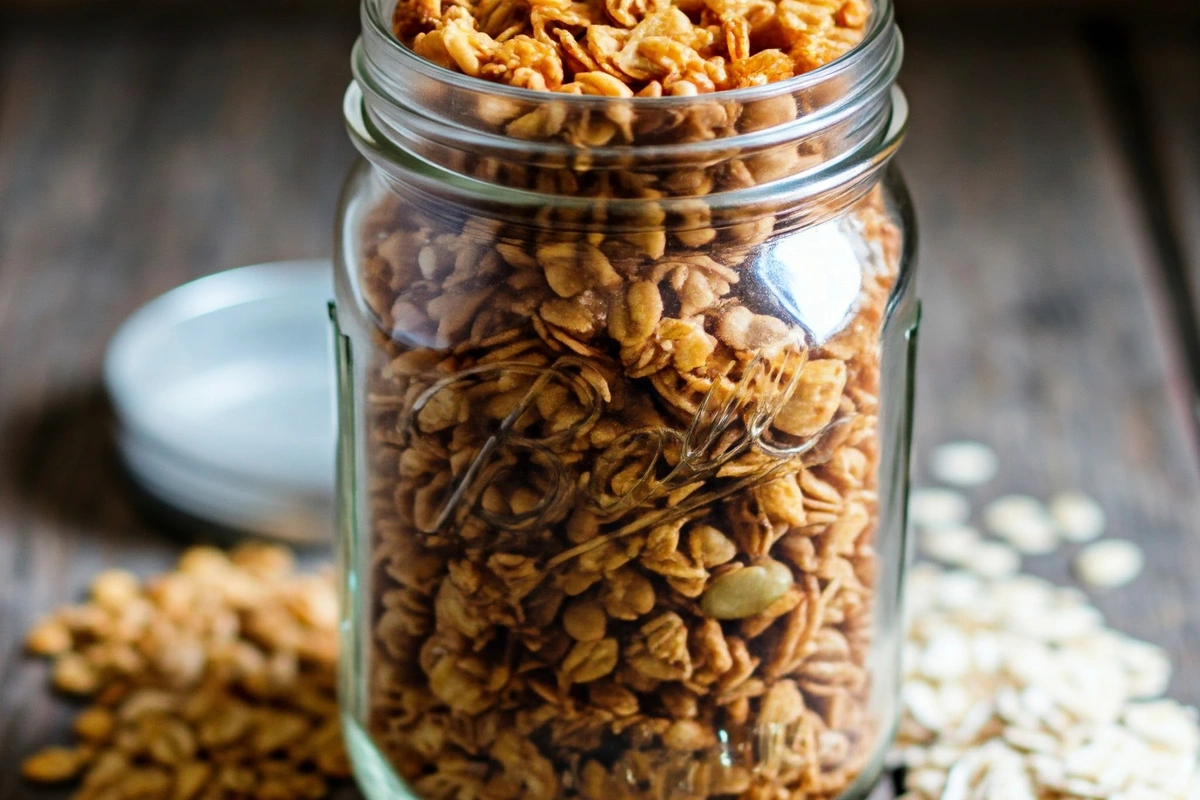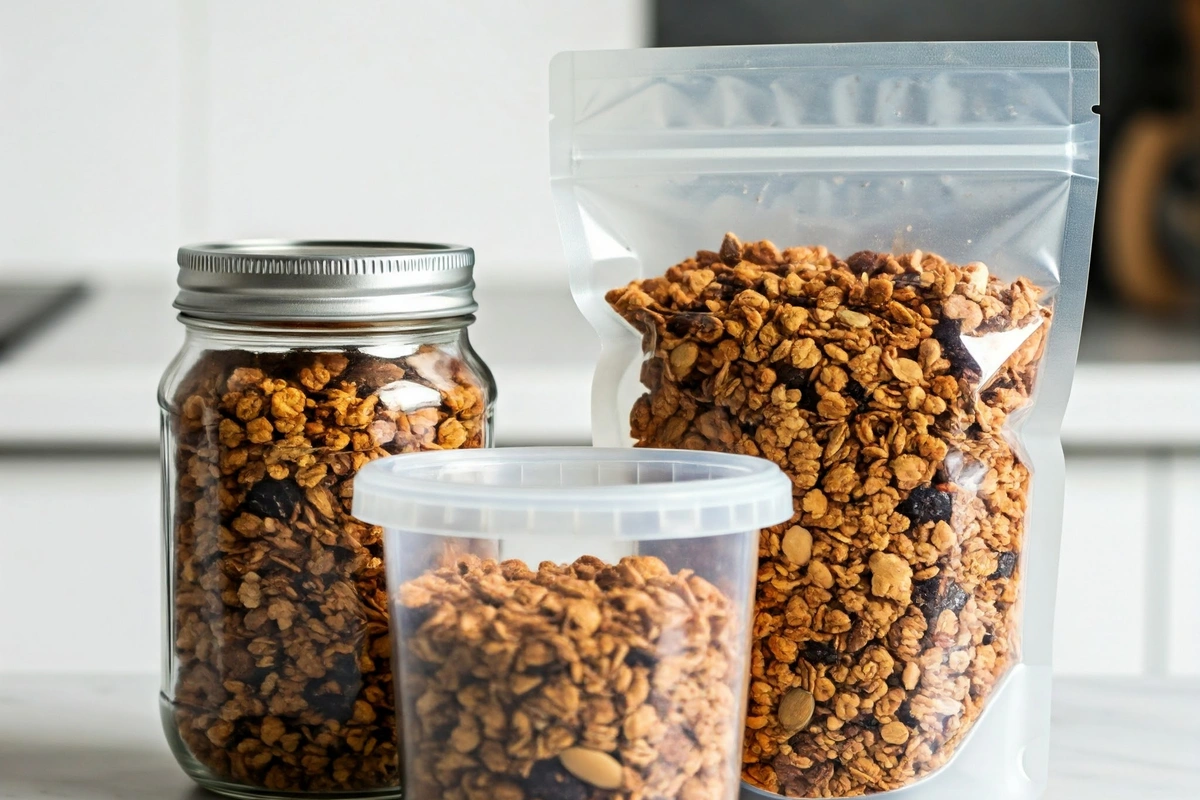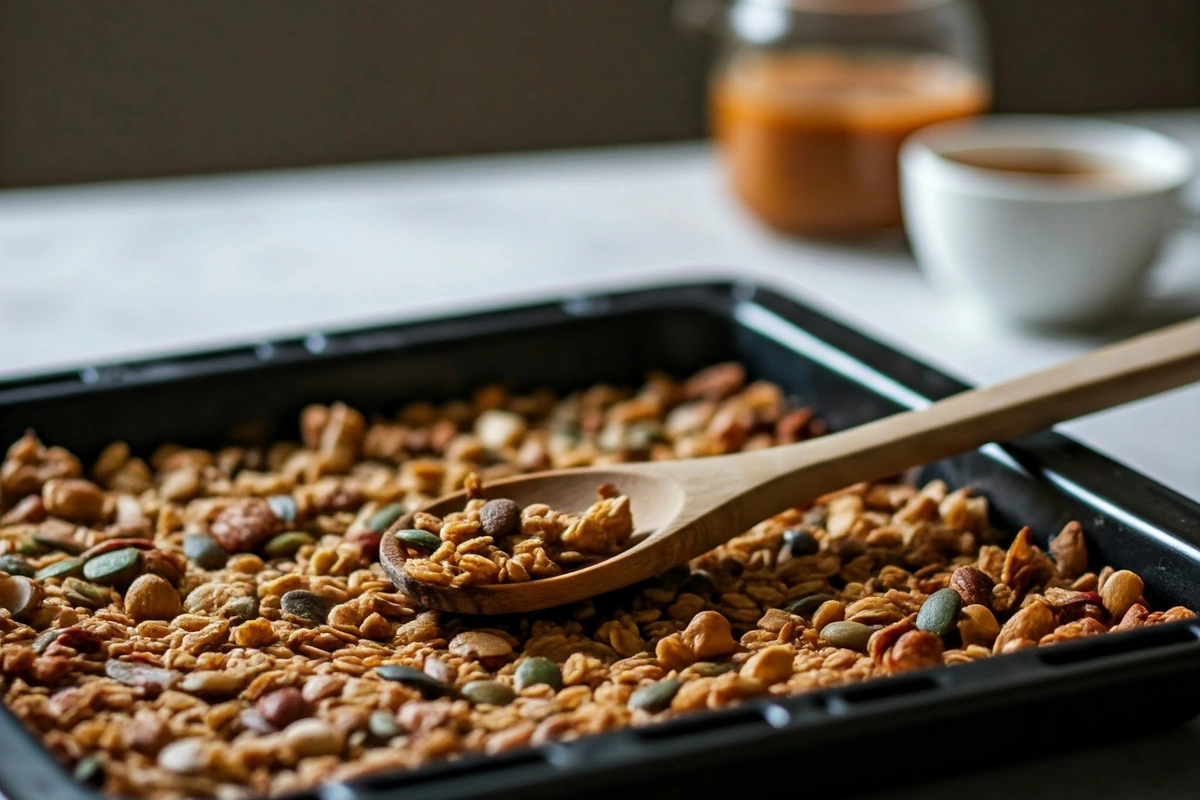Understanding how long does homemade granola last
Homemade granola is a delicious staple in many American households. It provides a crunchy texture and a versatile flavor base for breakfast bowls or on-the-go snacks. However, understanding how long does homemade granola last can help you enjoy every batch at its peak freshness. In general, homemade varieties can stay tasty for two to three weeks when stored correctly. Nevertheless, certain factors may cause your granola to spoil sooner.
Indeed, homemade granola lacks the preservatives often found in store-bought brands. This means it can be slightly more vulnerable to moisture, temperature fluctuations, and contamination from other ingredients. Consequently, it is crucial to store it in an airtight container and keep it in a cool, dry place. Equally, selecting high-quality ingredients extends its longevity. For instance, using fresh nuts, seeds, and dried fruits helps ensure a longer-lasting batch.
Furthermore, many people find homemade granola tastes better than its commercial counterpart. That extra crunch and the ability to customize ingredients is appealing. Yet, because you control the recipe, you must also take responsibility for proper storage. Subsequently, paying attention to simple strategies can preserve texture and flavor. Altogether, it is essential to understand how every aspect of preparation and storage can influence its shelf life.
In the following sections, you will discover how to prolong your granola’s crispness. You will also learn about signs of spoilage and the best containers to keep moisture away. Hence, you can enjoy each crunchy bite without worrying about waste. This knowledge can help you make larger batches or smaller ones, depending on your household’s consumption habits. Afterward, you will also find a handy FAQ section to address common concerns.
Factors Affecting how long does homemade granola last
Several elements influence how long does homemade granola last. Chiefly, these include ingredient quality, moisture levels, and overall storage conditions. When you combine fresh items in the right balance, you get an extended shelf life. Conversely, stale nuts or damp oats will reduce freshness significantly.
- Ingredient Quality: Always select high-quality oats, nuts, seeds, and sweeteners. If your nuts and seeds are near their expiration date, your granola will not remain fresh for very long. Basically, stale ingredients produce stale final products. Therefore, check labels and sniff for any odd smells before mixing.
- Moisture Content: Too much moisture is the enemy of crisp granola. While making it, measure wet ingredients like honey or oil accurately. Do not overuse them, because excessive moisture encourages mold growth. Additionally, ensure the granola is fully cooled before sealing it in a container to prevent trapped steam.
- Storage Temperature: Keep the container in a cool, dry spot. Warmer climates increase the chance of oils turning rancid. Meanwhile, extremely cold settings can affect texture. Therefore, storing granola at room temperature is often best for short-term freshness.
- Container Choice: Use airtight containers with secure lids. Plastic or glass containers work well, as long as they effectively lock out air. Some prefer zip-top plastic bags, but make sure you press out as much air as possible. Consequently, less air means a longer shelf life.
- Exposure to Light: Light can degrade certain nutrients in nuts and seeds. Consequently, it may speed up oxidation, causing rancidity sooner. Hence, storing granola in an opaque container or in a dark cupboard can help.
Altogether, these factors determine whether your granola stays crisp and delicious for days or weeks. In the next sections, we will delve deeper into each point. You will learn how to fine-tune storage habits to preserve flavor, crunch, and freshness for the longest possible time.
Storing to Extend how long does homemade granola last
Storing your homemade granola properly plays a vital role in extending how long does homemade granola last. Generally, you can keep it at room temperature for up to three weeks, provided you follow the right steps. Initially, ensure it is entirely cool. Placing warm granola in a container will trap steam, thus causing sogginess or mold over time.
Airtight Containers
Airtight containers or well-sealed jars are your granola’s best friends. The less air that circulates around it, the less likely it is to lose crispness. Furthermore, sturdy containers protect your granola from humidity. Humidity is especially relevant in certain regions of the United States. If you live in an area with high humidity, check your container’s seal frequently.
Location Matters
Store your container in a cool and dark pantry. This strategy shields your granola from direct sunlight and high temperatures. If your kitchen is especially hot, consider a storage cabinet farther from the stove or oven. Equally, keep it away from windows to prevent constant exposure to sunlight. An environment stable in temperature and humidity is ideal.
Batch Size
Some people prefer preparing large batches of granola. Yet, if you do not consume it quickly, the granola may lose its crunch. Therefore, consider splitting it into smaller airtight bags or jars. You can open one container at a time, keeping the rest safely sealed until needed. This method is particularly useful for meal-prepping families or individuals aiming to reduce waste.
Signs Your Granola Is Spoiled
Even if you do everything correctly, homemade granola can still turn bad eventually. Hence, it’s crucial to recognize telltale signs of spoilage. You want to know quickly if you need to toss it. Especially when you keep it for extended periods or experiment with new recipes, these signs matter.
- Off Smell
If your granola smells rancid or musty, that’s a major red flag. Nuts and seeds typically go rancid when exposed to air, heat, or moisture. Accordingly, always smell your granola before eating it if it’s been sitting around for a while. - Funky Taste
Sometimes, the odor might not change drastically, but the flavor will. If you notice a bitter or stale taste, it might be time to discard your granola. Nevertheless, a mild stale note might not be dangerous. Yet, it likely won’t be enjoyable either. - Visible Mold
Mold growth indicates moisture infiltrated your container. This can happen if you sealed the granola while it was still warm or if the container wasn’t airtight. Undoubtedly, moldy granola must be thrown away immediately. - Texture Changes
Homemade granola should remain crisp. Consequently, if it feels excessively soft or chewy, it may be compromised. Although it might still be safe to eat if there’s no mold, it probably won’t taste as good.
All these spoilage indicators help you stay safe and prevent unpleasant experiences. If you detect any one of them, discard the granola to avoid potential health risks. When in doubt, throw it out. Meanwhile, keep reading to learn more about specific storage methods that further prolong its life.
The Impact of Ingredients on Shelf Life
The ingredients you choose can significantly affect freshness. In particular, nuts and seeds with higher oil content can become rancid faster. For example, walnuts and pecans have richer oils than almonds or sunflower seeds. Consequently, if you use large amounts of high-oil nuts, your granola might need more attentive storage.
Moreover, dried fruits are a common addition. They can introduce extra moisture or even sugar, which can influence microbial growth. However, dried fruits typically have low water content. Still, it’s wise to check for any dryness issues before mixing them into your granola. If the fruit is already stiff or crystallized, it might not combine optimally. Therefore, consider adding dried fruits only after baking your oats and nuts. This ensures minimal moisture remains trapped in the final product.
Sweeteners, such as honey, maple syrup, or brown sugar, also matter. They bind ingredients together. Nonetheless, if too much sweetener is used, the granola could become clumpy and hold moisture. This can reduce its overall shelf life. To avoid this, measure accurately and bake the mixture thoroughly.
Spices, like cinnamon or nutmeg, can enrich flavor. They do not drastically affect shelf life, provided they are fresh. However, any added spice or flavoring can lose potency over time, especially if exposed to air or light. Ideally, keep spices in sealed containers and mix them in just before baking.
Finally, always label your ingredients. This helps you track their individual freshness. By using the freshest possible items, you can enjoy granola that remains crunchy and delicious for a longer stretch of time.
Tips for Preventing Moisture Buildup
Moisture is the primary threat to homemade granola. Subsequently, you must take active steps to avoid it. Below are some specific suggestions:
- Cool Thoroughly
Let your granola cool on a baking sheet before transferring it to a container. Generally, 20 to 30 minutes is sufficient, depending on your kitchen’s temperature and humidity. Basically, any remaining warmth can create steam, so patience is crucial. - Add Extras Later
If you plan to add chocolate chips, drizzle, or fruit, wait until the granola is completely cool. Warm granola can melt chocolate or release water from fruit. This results in clumping or soft spots. - Use Desiccant Packs
Some people use small food-safe desiccant packets in their containers. These absorb any extra moisture. While not always necessary, it can be helpful in very humid conditions. - Avoid Cross-Contamination
Keep granola away from other items that produce moisture. For instance, storing it next to fresh produce in your pantry could introduce humidity. Instead, place it alongside dry goods like flour, rice, or pasta.
These strategies may seem straightforward, but they are effective. By controlling moisture, you extend how long does homemade granola last. Eventually, it becomes second nature. After a few batches, you will find it easy to incorporate these tips into your routine.
Why Crunchiness Matters
Crunchiness is often the defining quality of a good granola. It provides a pleasant texture that contrasts with soft ingredients li
ke yogurt or milk. Equally, it improves the snacking experience when you eat granola on its own. Therefore, preserving crunch is essential to enjoying it fully.
To retain that crunch, your baking process is critical. Spread the mixture evenly on a baking sheet, ensuring even heat distribution. Stir the granola halfway through baking to prevent burning and create uniform browning. Eventually, you will find a perfect balance between golden and crisp, without getting too dark.
Additionally, do not skip the cooling step after baking. The granola continues to firm up as it cools. If you seal it too soon, steam will undo the crisp texture. Particularly in the final stages of preparation, be mindful of timing. Once you get the desired crunch, promptly remove the tray from the oven. Over-baking causes a bitter aftertaste.
Altogether, a crunchy texture is more than just preference. It indicates your granola is properly cooked and free from excess moisture. By combining proper baking, cooling, and storage, you can maintain a crunchy consistency for weeks.
Common Variations and Their Effect on Freshness
Homemade granola can be highly customized. You can add ingredients like coconut flakes, freeze-dried fruit, or even nut butter. Each variation may alter its shelf life. For instance, coconut flakes can sometimes absorb or release moisture depending on how they are toasted. Consequently, your final product might have a slightly different texture.
Freeze-dried fruit tends to be very low in moisture. It usually doesn’t affect crispness negatively. In fact, freeze-dried fruit can help keep the overall texture crunchy. Conversely, fresh fruit or fruit purees can significantly reduce the granola’s shelf life. If you want to add fresh fruit, it’s best to do so right before eating. This prevents extra water from infiltrating the dry ingredients.
Nut butters, such as peanut butter or almond butter, can be a delicious addition. However, they bring added oils. This might affect how long your granola remains fresh. Consequently, be mindful of the type and quantity of nut butter you use. Proper baking is key to ensuring the mixture dries out enough. Furthermore, storing peanut butter-based granola in the fridge can sometimes prolong its freshness. Nevertheless, it may slightly alter texture.
Ultimately, experimenting with variations can keep your meals interesting. Equally, it’s fun to explore different textures, flavors, and nutritional profiles. Just remember to adjust storage practices accordingly.
Nutritional Information (Per 100g)
Below is a general approximation of the nutritional values for a classic homemade granola recipe. Keep in mind that actual figures vary based on specific ingredients and proportions:
| Nutrient | Approx. Value |
|---|---|
| Calories | 450 kcal |
| Total Fat | 15 g |
| Saturated Fat | 3 g |
| Carbohydrates | 65 g |
| Dietary Fiber | 7 g |
| Sugars | 15 g |
| Protein | 10 g |
| Sodium | 150 mg |
These numbers serve as a rough guide. If you add extra nuts and seeds, the fat and protein content increases. Conversely, if you use less sweetener or skip dried fruit, you reduce the sugar content. Always adjust according to your dietary goals.
Baking Tips for Longevity
Baking your granola thoroughly is another secret to extending how long does homemade granola last. When oats and nuts are properly baked, they lose much of their internal moisture. This dryness helps them resist mold growth. However, be cautious not to over-bake and burn your granola.
- Temperature Control
Set your oven between 300°F and 350°F, depending on your recipe. If the temperature is too high, the outer edges burn before the center is cooked. Consequently, burning shortens shelf life because it creates off flavors. - Stirring Method
Stir at least once or twice during baking. This ensures even browning. If you leave it untouched, the edges might brown faster, leading to inconsistent texture. Altogether, occasional stirring can prevent hot spots. - Baking Duration
Most granola recipes need 20 to 30 minutes in the oven. However, the exact time may vary. Eventually, you want a golden color with a fragrant, toasty aroma. Extend the baking time by a few minutes if the mixture still feels damp. - Proper Cooling
Spread the granola out on a baking sheet. Let it cool fully. Ideally, it should be at room temperature. Placing hot granola in a closed container traps steam. Consequently, it becomes soggy.
With these baking tips, you can produce a consistent, crunchy texture each time. Accordingly, you’ll feel more confident in storing it and enjoying it later. Good baking practices and careful ingredient selection work hand in hand to maximize your granola’s shelf life.
How long does homemade granola last in the Fridge?
You may wonder if refrigeration helps with how long does homemade granola last. Generally, keeping granola in the fridge is not necessary. The cool temperature can help slow down rancidity of oils. However, the fridge often has more moisture than a pantry. Therefore, condensation might form. This can lead to clumping or spoilage if the container is not perfectly airtight.
Nevertheless, certain granola variations benefit from fridge storage. For example, if you incorporate fresh fruit puree or nut butter, you might consider refrigeration. Even then, place it in a tightly sealed container, preferably with a desiccant pack. Still, check frequently for signs of moisture buildup. If you notice any dampness, switch to freezer storage or revert to a dry pantry if possible.
How long does homemade granola last at Room Temperature?
For most standard recipes, storing granola in a cool, dry place is ideal. This method preserves the best flavor and texture. Typically, how long does homemade granola last at room temperature is around two to three weeks. To ensure maximum freshness:
- Keep it in an airtight container.
- Store it away from direct sunlight and heat sources.
- Use clean utensils or hands when scooping granola to avoid contamination.
Eventually, if you notice any off smell, taste, or appearance, discard it. Nonetheless, well-made granola kept in optimal conditions can remain delicious for nearly a month. Each batch might vary slightly based on ingredients and overall humidity.
How long does homemade granola last in the Freezer?
Freezer storage can extend how long does homemade granola last up to six months or more. Because freezing halts the processes that cause rancidity, it preserves flavors and textures effectively. Moreover, freezing is an excellent option if you want to prepare large batches for future use.
To freeze granola successfully, follow these steps:
- Cool Completely
Ensure the granola is at room temperature. Freezing warm granola creates condensation, which later leads to freezer burn. - Use Proper Packaging
Place granola in a freezer-safe, airtight container or zip-top bag. Squeeze out as much air as possible. Label the container with the date. - Thaw Carefully
When you need granola, remove it from the freezer and let it thaw at room temperature in its sealed container. This reduces the risk of moisture forming inside the bag or container.
Freezing can slightly change the texture for some variations. However, most people find no noticeable difference once the granola is thawed. It remains crunchy if sealed well. Undoubtedly, it’s a handy method for busy households or those who like to plan ahead.
Recrisping Stale Granola
Occasionally, your granola may become soft. But stale does not always mean spoiled. As long as it doesn’t show signs of mold or rancidity, you can bring back some of its crunch. Spread it on a baking sheet and bake at 300°F for 5 to 10 minutes. Stir halfway, then let it cool. This process dries out the excess moisture and helps restore crispness.
Be mindful not to over-bake during this reheating process. Check frequently to avoid burning. Furthermore, if your granola has bits of chocolate or sensitive add-ins, be aware they might melt. In that case, you may want to remove those pieces before recrisping. This easy step can reduce waste and help you enjoy a crunchy snack again.
Using Proper Containers for Maximum Shelf Life

The right container makes all the difference in preserving your homemade granola. Here are some popular container choices:
- Glass Jars with Sealed Lids: Mason jars are sturdy and reusable. Their lids usually provide a tight seal. They are transparent, which lets you see how much granola is left. However, remember that glass doesn’t block light unless it’s tinted or stored in a dark place.
- Plastic Storage Containers: Many plastic containers come with snap-on lids that are fairly airtight. They are lightweight and less breakable. Just ensure the plastic is food-grade and BPA-free.
- Mylar Bags: Mylar bags with zip locks or heat seals are extremely effective at blocking air and light. People often use them for long-term food storage. However, these bags can be more expensive and less reusable.
- Zip-Top Plastic Bags: These are convenient for short-term storage or travel. Nonetheless, make certain to squeeze out as much air as possible. Consider double-bagging if you plan to keep the granola for longer than a week.
Ultimately, choose a container that suits your lifestyle. If you take granola to work or school, smaller containers may be practical. On the other hand, if you store large batches at home, big jars or Mylar bags might be ideal.
Maximizing Freshness Through Layering
Layering ingredients strategically can help keep your granola fresh. For example, some people add dried fruits or chocolate chips at the bottom or in separate compartments. This approach prevents those items from mixing with the main batch if they can cause moisture or melting issues. Particularly for those who like to meal prep individual servings, layering can help.
You can use small food containers with compartments or simply place fruit in a separate small bag. Then, combine the components right before eating. Basically, this method ensures each component retains its ideal texture. It’s a small trick, but it can significantly enhance your granola experience, especially if you enjoy it on the go.
Conclusion: Enjoying Your Granola at Its Best
By now, you have a thorough understanding of the crucial elements that affect how long does homemade granola last. Fresh, quality ingredients, controlled baking, and proper storage conditions all work together to maximize crispness and flavor. Indeed, your granola can stay delicious for up to three weeks at room temperature, or even longer when stored in the freezer. Take care to avoid moisture buildup and pay attention to the container you use.
Homemade granola is a delightful and customizable snack. With the right tips, you can enjoy every batch for days or weeks without compromising on flavor. Make sure to monitor signs of spoilage and practice good baking techniques. Eventually, you might discover your perfect recipe and storage routine that consistently yields crunchy, tasty granola. Share it with family and friends, or keep it all to yourself. However you choose to enjoy it, you now have the knowledge to maintain its freshness as long as possible.
FAQs (People Also Ask)
Q1: Can homemade granola really last for two to three weeks?
Yes, it usually can. When baked thoroughly and stored in an airtight container in a cool, dry spot, homemade granola maintains good quality for about two to three weeks. Generally, it can even last up to a month if conditions are optimal. Nonetheless, always check for signs of spoilage like rancid smells, mold, or unwanted softening.
Q2: Is it safe to add fresh fruit to homemade granola?
Adding fresh fruit introduces moisture, which can drastically shorten the shelf life. It’s best to add fresh fruit right before eating. If you want fruit in your granola mix, choose dried or freeze-dried versions to keep it crunchy and shelf-stable.
Q3: Does vacuum sealing help increase how long does homemade granola last?
Vacuum sealing removes air and can delay oxidation, which is beneficial. However, you must still ensure the granola is completely cool and moisture-free before sealing. Otherwise, trapped moisture could lead to mold growth. If done properly, vacuum sealing is an excellent way to preserve freshness, especially for long-term storage.
Q4: Will stirring the granola during baking affect its shelf life?
Stirring helps the granola bake evenly, ensuring each piece dries out thoroughly. This consistent dryness aids in preserving its crisp texture. Therefore, stirring can indeed help extend shelf life by preventing any soft, moist spots that encourage spoilage.
Q5: Should I refrigerate or freeze homemade granola?
For standard recipes, refrigeration isn’t usually recommended because the fridge can contain moisture. However, freezing is an excellent way to extend shelf life. If sealed well, you can freeze homemade granola for up to six months without losing much in texture or flavor.

